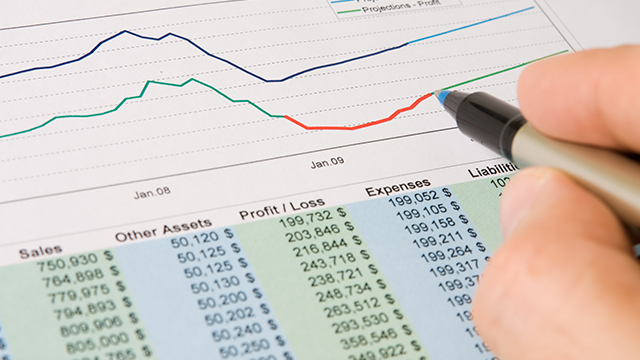A balance sheet is a snapshot of how financially healthy your business is. It could tell you whether you’re well prepared to jump on new opportunities or even how attractive your company might be to a potential buyer or investor.
How to read a balance sheet
September 27, 2024 | 4 minute read
What a balance sheet includes
All balance sheets lay out three basic kinds of information about your business: assets, liabilities and shareholders’ equity. When you look at the data together, it gives you a quick glimpse of your business’s financial status.
Haven’t seen a balance sheet? Picture a page. On the left-hand side, there’s a list of assets. These are things that the business owns, such as cash in a bank account, inventory, computer equipment and receivables. This list may even include what’s called goodwill — intangibles like your reputation from years of building relationships with customers, or the value of your logo and brand.
The right-hand side is divided into a top and a bottom part. First, there’s a list of liabilities — what the business owes, such as accounts payable (the amount owed to vendors), obligations to banks for loans and back pay to employees.
Below that is a space for shareholders’ equity, which is anything that would be left over after all the company’s liabilities are satisfied. In a small business, the owner is often the sole shareholder.
The page you’ve just imagined is a balance sheet.
A balance sheet is based on a simple formula: assets = liabilities + shareholders’ equity. This formula shows how the things a company owns (assets) were paid for. Either the owners have invested money in them (this is called shareholders’ equity) or have taken out debt (liabilities) to pay for them.
When balance sheets are done correctly, the formula always balances out. So, let’s say your business purchases a new set of office furniture that costs $10,000 (which would be listed as an asset). You paid $2,000 in cash and put the remaining $8,000 on a credit card. The $2,000 would be subtracted from cash under assets and the $8,000 would be shown as a liability. That would reflect a net impact of $8,000 on both sides of the balance sheet.
What a balance sheet is used for
Balance sheets can give you clues to your business’s ability to withstand an economic or competitive shock or invest in new products and services. You can get a glimpse into how the business is performing on many fronts by looking at the ratios between the columns. For instance, a company that consistently has large amounts of cash on hand and very few liabilities may not be investing enough in growth. Or a company that has taken on a lot of debt but has few assets may need to find new ways to bring in revenue, or possibly restructure the debt, for the debt to be sustainable.
To take the pulse of their business, many small business owners keep an eye on simple ratios such as the current ratio (current assets/current liabilities), the quick ratio (cash and cash equivalent/current liabilities) and the debt-to-asset ratio (liabilities/assets).
These are just a few of the variety of ratios you can track to take the pulse of your business. Your accountant can help you determine which ratios are the most important to the health of your business.
How can you create a balance sheet?
Software programs and accounting services make it easy to create balance sheets, practically at the touch of a button. To create an accurate balance sheet, you will need to make sure your bookkeeping is up to date and that you or your bookkeeper have correctly categorized each entry.
For instance, if you took out a $20,000 loan, you would likely categorize the proceeds of the loan as “cash or cash equivalent” and put it under the liabilities category as long-term debt.
If you got an investment of $50,000, it would appear in the assets column and in the shareholders’ equity column. Revenues that exceed expenses also belong in the shareholders’ equity column.
Remember, the objective is to balance both sides of your balance sheet.
When do you create a balance sheet?
A balance sheet is something you should create early in the life of your business and maintain on an ongoing basis. Most business owners look at their balance sheets monthly, quarterly or yearly, when they want to get a clearer picture of the underlying health of the business. The ratios become particularly useful when you establish a handful that you look at regularly and see how they change over time.
Other times you may need to create a balance sheet are when you file your business taxes, if you apply for a business loan or if potential buyers are interested in purchasing your business. The more accurate your books, the easier it will be to create a balance sheet.
It can take a while to get comfortable with balance sheets. Making time to create one with your accountant, bookkeeper or banker can help you get up to speed. There’s a learning curve, but once you know how to create one, you’ll always have your finger on the pulse of your business.
Explore more
Understanding a profit and loss (P&L) statement
Is your business profitable? Are costs reasonable? Are enough sales being generated? A P&L statement can help you answer these critical questions.
How to find investors for your small business
The right investors can provide a wealth of benefits beyond the money they bring to your business - from access to their professional network to well-grounded advice.
Important Disclosures and Information
Bank of America, Merrill, their affiliates and advisors do not provide legal, tax or accounting advice. Consult your own legal and/or tax advisors before making any financial decisions. Any informational materials provided are for your discussion or review purposes only. The content on the Center for Business Empowerment (including, without limitations, third party and any Bank of America content) is provided “as is” and carries no express or implied warranties, or promise or guaranty of success. Bank of America does not warrant or guarantee the accuracy, reliability, completeness, usefulness, non-infringement of intellectual property rights, or quality of any content, regardless of who originates that content, and disclaims the same to the extent allowable by law. All third party trademarks, service marks, trade names and logos referenced in this material are the property of their respective owners. Bank of America does not deliver and is not responsible for the products, services or performance of any third party.
Not all materials on the Center for Business Empowerment will be available in Spanish.
Certain links may direct you away from Bank of America to unaffiliated sites. Bank of America has not been involved in the preparation of the content supplied at unaffiliated sites and does not guarantee or assume any responsibility for their content. When you visit these sites, you are agreeing to all of their terms of use, including their privacy and security policies.
Credit cards, credit lines and loans are subject to credit approval and creditworthiness. Some restrictions may apply.
Merrill Lynch, Pierce, Fenner & Smith Incorporated (also referred to as “MLPF&S” or “Merrill”) makes available certain investment products sponsored, managed, distributed or provided by companies that are affiliates of Bank of America Corporation (“BofA Corp.”). MLPF&S is a registered broker-dealer, registered investment adviser, Member SIPC, and a wholly owned subsidiary of BofA Corp.
Banking products are provided by Bank of America, N.A., and affiliated banks, Members FDIC, and wholly owned subsidiaries of BofA Corp.
“Bank of America” and “BofA Securities” are the marketing names used by the Global Banking and Global Markets division of Bank of America Corporation. Lending, derivatives, other commercial banking activities, and trading in certain financial instruments are performed globally by banking affiliates of Bank of America Corporation, including Bank of America, N.A., Member FDIC. Trading in securities and financial instruments, and strategic advisory, and other investment banking activities, are performed globally by investment banking affiliates of Bank of America Corporation (“Investment Banking Affiliates”), including, in the United States, BofA Securities, Inc., which is a registered broker-dealer and Member of SIPC, and, in other jurisdictions, by locally registered entities. BofA Securities, Inc. is a registered futures commission merchant with the CFTC and a member of the NFA.
Investment products:


